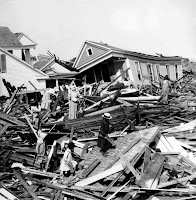
The Galveston Hurricane of 1900 made landfall on the city of Galveston, Texas on September 8, 1900. It had estimated winds of 135 mph (215 km/h) at landfall, making it a Category 4 storm on the Saffir-Simpson Hurricane Scale.
The hurricane caused great loss of life with the estimated death toll between 6,000 and 12,000 individuals the number most cited in official reports is 8,000, giving the storm the third-highest number of casualties of any Atlantic hurricane, after the Great Hurricane of 1780 and 1998’s Hurricane Mitch. The Galveston Hurricane of 1900 is to date the deadliest natural disaster ever to strike the United States. By contrast, the second-deadliest storm to strike the United States, the 1928 Okeechobee Hurricane, caused approximately 2,500 deaths, and the deadliest storm of recent times, Hurricane Katrina, claimed the lives of approximately 1,800 people.
The hurricane occurred before the practice of assigning official code names to tropical storms was instituted, and thus it is commonly referred to under a variety of descriptive names. Typical names for the storm include the Galveston Hurricane of 1900, the Great Galveston Hurricane, and, especially in older documents, the Galveston Flood. It is often referred to by Galveston locals as The Great Storm or The 1900 Storm. There is existing film of the damage caused by the storm, which is considered the oldest motion picture film of a real-life occurrence surviving today, and was filmed by Thomas Edison's employees.

The highest measured wind speed was 100 mph (160 km/h) just after 6 p.m., but the Weather Bureau’s anemometer was blown off the building shortly after that measurement was recorded. The eye passed over the city around 8 p.m. Maximum winds were estimated at 120 mph (190 km/h) at the time, but later estimates placed the hurricane at the higher Category 4 classification on the Saffir-Simpson Scale.At the time of the 1900 storm, the highest point in the city of Galveston was only 8.7 ft (2.7 m) above sea level. The hurricane had brought with it a storm surge of over 15 ft (4.6 m), which washed over the entire island. The surge knocked buildings off their foundations, and the surf pounded them to pieces. Over 3,600 homes were destroyed, and a wall of debris faced the ocean. The few buildings which survived, mostly solidly-built mansions and houses along the Strand District, are today maintained as tourist attractions.
As terrible as the damage to the city’s buildings was, the human cost was even greater. Due to the destruction of the bridges to the mainland and the telegraph lines, no word of the city’s destruction was able to reach the mainland. The citizens of Houston knew a powerful storm had blown through and had made ready to provide assistance. Workers set out by rail and ship for the island almost immediately. Rescuers arrived to find the city completely destroyed. Eight thousand people — 20% of the island’s population — had lost their lives. Most had drowned or been crushed as the waves pounded the debris that had been their homes hours earlier. Many survived the storm itself, but died after several days trapped under the wreckage of the city, with rescuers unable to reach them. The rescuers could hear the screams of the survivors as they walked on the debris trying to rescue those they could. They realized that there was no hope.
More people were killed in this single storm than have been killed in the over three hundred hurricanes that have struck the United States since, combined, as of 2006. Thus, the Galveston Hurricane of 1900 remains the deadliest natural disaster in U.S. history.
Our building survived this storm...
More HERE
No comments:
Post a Comment